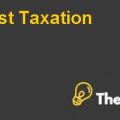
CASE # 01:
Tax evasion is mainly related to the omission of income on a tax return, which is done deliberately and it may also be comprised of the non-payment of taxes as well as not making a submission of tax returns. The reason behind this activity is to avoid making the payment of taxes over the income that has been earned by the individual or an enterprise.
Moreover, tax evasion is a felony and whoever performs this activity will have to face the imprisonment of almost five years and the amount of penalty that will have to be paid by the individual is almost $100,000. On contrary to this, if the corporations adopt this illegal approach, then it may result in a massive penalty of almost $500,000.
However, it should be noticed that the submission of the false tax return only takes place when an individual has provided inaccurate information on a tax return that he is going to submit. Moreover, the Internal Revenue Service IRS and the federal government have devised several penalties in order to prevent the individuals and enterprises to commit tax evasion.
The rules and regulations implemented in most of the countries are quite strict and it is evident from the fact that even if an individual or corporation has not evaded the tax even then they can become a subject of audit. The IRS also mentions that if a person has committed tax evasion then as a result the suspected person has given a right to get himself involved in a hearing with the IRS.
Despite this, its consequences based upon the filing of an inaccurate tax return include severe penalties like three years in prison and a penalty of almost $100,000. In order to prove the tax evasion on an individual, Internal Revenue Service has to provide evidence merely regarding the misrepresentation made by the individual in terms of information on a tax return. However, if an individual has failed in submitting a tax return, then this act can lead to the imprisonment for a period of one year and the amount of penalty that he will have to pay is almost $25,000.
However,it must be noticed that the amount of penalties and the duration of imprisonment that areset by the Internal Revenue Service IRS and the Federal government are subject to amendments if any that are required by these legal authorities. Moreover, there is also an opportunity that if a taxpayer makes a submission of the amended tax returns as well as he starts to pay the outstanding amount that he did not intend to pay before, then the Internal Revenue Service IRS will not pursue any criminal charges against that individual or corporation.
In addition to this, some of the penalties based upon the tax evasion are the fixed dollar amounts or they can also be fixed percentage of some measure. There is also a chance that if the taxpayer has been asked to make an additional payment of the tax required by the Internal Revenue Service then the taxpayer is liable to penalty of almost 0.5% on a monthly basis. Hence, this is the period in which the failure continues and if the amount required by the IRS has not been paid within 21 calendar days then it can take further actions against the taxpayer.
Moreover, if a taxpayer has filed an income tax or excise return and there is an outstanding balance shown, but the taxpayer does not make a payment of that balance on a due date then a different charge may be applied regarding the penalties related to the tax evasion. As a result, the tax payers will have to take into account all the above mentioned consequences in order to avoid committing this severe crime in future.
CASE # 02:
Julie is professionally a singer in the Non-Profit City Symphony Chorus and the members of the CSS comprise of men and women. In addition, men are required to incur an expenditure of almost $500 for the tuxedos and women are required to incur $300 for long black gowns. Hence, the amount of contribution made by Julie is almost $15,000 therefore,based on this fact as per the exhibits it can be seen that the amount of deduction that she can make is almost $300. This figure has been obtained by deducting the annual contributions of $15,000 made by Julie from Julie’s expenditure of almost $15,300 as per the exhibits..................................
This is just a sample partial case solution. Please place the order on the website to order your own originally done case solution













